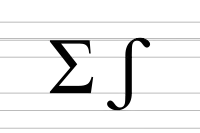Esh (letter)
Esh (majuscule: Ʃ Unicode U+01A9, minuscule: ʃ Unicode U+0283) is a character used in phonology to represent the voiceless postalveolar fricative (English ⟨sh⟩, as in "ship").
| Ʃ | |
|---|---|
| Ʃ ʃ | |
| (See below) | |
 | |
| Usage | |
| Writing system | Latin script |
| Type | Alphabetic and Logographic |
| Language of origin | Latin language |
| Phonetic usage | [ʃ] /ˈɛʃ/ |
| Unicode codepoint | U+01A9, U+0283 |
| History | |
| Development | |
| Time period | 1847 to present |
| Descendants | None |
| Sisters |
Disputed: |
| Variations | (See below) |
| Other | |
| Other letters commonly used with | s(x), sh, š |
| Writing direction | Left-to-Right |
Form, usage, and history
Its lowercase form ⟨ʃ⟩ is similar to an integral sign ⟨ʃ⟩ or a long s ⟨ſ⟩ with an extra leftward hook at the bottom; in 1928 the Africa Alphabet borrowed the Greek letter sigma for the uppercase form ⟨Ʃ⟩. The lowercase form was introduced by Isaac Pitman in his 1847 Phonotypic Alphabet to represent the voiceless postalveolar fricative (English sh). It is today used in the alphabets of some African languages, as well as in the International Phonetic Alphabet.
The International Phonetic Alphabet (IPA) uses U+0283 ʃ LATIN SMALL LETTER ESH to represent a voiceless palato-alveolar sibilant. Related obsolete IPA characters include U+01AA ƪ LATIN LETTER REVERSED ESH LOOP, U+0285 ʅ LATIN SMALL LETTER SQUAT REVERSED ESH, and U+0286 ʆ LATIN SMALL LETTER ESH WITH CURL.
U+AB4D ꭍ LATIN SMALL LETTER BASELINE ESH is used in the Teuthonista phonetic transcription system.[1]
Variations of esh are used for other phonetic transcription:[2] ⟨ᶋ⟩, ⟨ᶘ⟩, ⟨ʃ⟩.
U+1DF0B 𝼋 LATIN SMALL LETTER ESH WITH DOUBLE BAR and U+1DF0C 𝼌 LATIN SMALL LETTER ESH WITH DOUBLE BAR AND CURL are used as click letters.[3][4]
See also
- ⟨ſ⟩ (the archaic 'long s' letterform)
- ⟨σ⟩ (the Greek letter 'sigma')
- ⟨Ш⟩ (the Cyrillic letter 'sha')
- ⟨Š⟩ (S with caron)
- ⟨Ş⟩ (S-cedilla)
- ⟨ഽ⟩ (Praslesham)
- ⟨Sz⟩ (a Polish digraph)
- ⟨Sh⟩ (an English and Albanian digraph)
- Latin-script S-based digraphs (including the Italian ⟨sc⟩, English ⟨sh⟩, and Norwegian and Faroese ⟨sk⟩)
- Latin-script S-based trigraphs (including German ⟨sch⟩ and Italian ⟨sci⟩)
References
- Everson, Michael; Dicklberger, Alois; Pentzlin, Karl; Wandl-Vogt, Eveline (2011-06-02). "L2/11-202: Revised proposal to encode "Teuthonista" phonetic characters in the UCS" (PDF).
- Constable, Peter (2004-04-19). "L2/04-132 Proposal to add additional phonetic characters to the UCS" (PDF).
- Miller, Kirk; Sands, Bonny (2020-07-10). "L2/20-115R: Unicode request for additional phonetic click letters" (PDF).
- Anderson, Deborah (2020-12-07). "L2/21-021: Reference doc numbers for L2/20-266R "Consolidated code chart of proposed phonetic characters" and IPA etc. code point and name changes" (PDF).